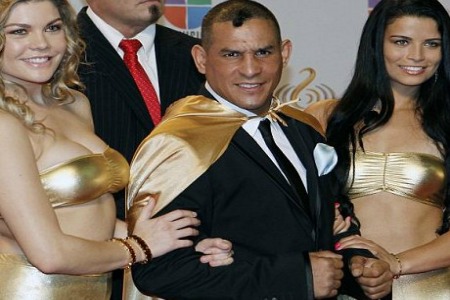
(Photo Credit: Hector Camacho in Vegas before a title fight. – Jon Gaede photo)
COMMENTARY
In many cases tragedy seems to shadow the practitioners of the Sweet Science. It is my hypotheses most of those that engage in professional fisticuffs are on that stage to uplift their lives or families from an entrenched placement in the lower-socio economics of life.
Living and fighting to get out of the lower-socio economic conundrum of humanity, the escapees seem to find misfortune at some point – financially, domestically or professionally.
Unfortunately, the numbers of great boxers that have endured tragic endings are too many for me to recount. Vernon Forrest, Alexis Argüello, Arturo Gatti, Steve McCrory, Michael Dokes, and Joe Frazier just to name a few.
The latest of the Sweet Science champions to have the 10-count rung is Hector “Macho” Camacho. On November 20, 2012, Camacho was shot once in the jaw while in his hometown of Bayamón, Puerto Rico. Several news agencies reported that Camacho, 50, was seated in the passenger seat of a friend’s Ford Mustang when he was shot by unknown individuals from a passing SUV.
The driver of the car, Adrian Mojica Moreno, a childhood friend of Camacho, was killed in the attack. Camacho was taken to San Pablo Hospital in Bayamón, where he was reported to be in critical condition.
The bullet pierced Camacho’s left cheek, and fractured his fifth and sixth cervical vertebrae, lodging in his right shoulder, and causing a lesion to his carotid artery which restricted blood flow to his brain. At one point, doctors announced that Camacho was expected to survive but might be paralyzed; however, after he suffered a cardiac arrest during the night, the next morning doctors reported that Camacho was clinically brain dead. Dr. Ernesto Torres said in response to his family’s request, he was taken off life support and died shortly thereafter.
I wrote from three of Camacho’s title fights. The first was a loss to Julio César Chávez in 1991 at Thomas & Mack Center, Las Vegas, Nevada. Again I scribed in 1994 at the Las Vegas MGM Grand Garden Arena, where Félix Trinidad gave him his third professional loss. And finally, in 1997 at the Convention Center in Atlantic City, New Jersey, where he beat legend Sugar Ray Leonard with a fifth round TKO.
Camacho also fought at the Detroit Joe Louis Arena, in 2000, where he earned a victory against Bobby Elkins.
My personal remembrance of Camacho was that he was a unique athlete. He learned from Muhammad Ali that one could milk the genre while adding, along with pure skill of being a combatant, the entertainment value of the sporting event.
I made sure I was at his big title fights, because he gave one a show. His in ring garb, his good looks, ring savvy, and his charisma were things that made him standout.
Before being taken to the United States, Camacho’s body laid in state at the Puerto Rico Department of Sports and Recreation in Santurce. During the two days Camacho’s body was on viewing, hundreds of people visited the facilities to pay tribute to the fighter.
Camacho was truly a Puerto Rican sports icon who many boxing journalist put in the conversation as one of the “Top 5 Puerto Rican boxers” of all time, along with Trinidad, Wilfredo Gómez, and Wilfredo Benitez..
The boxing historian, Mario Rivera Martinó, said Camacho, was a “complete fighter” in the Lightweight division.. World Boxing Council president José Sulaimán noted that Camacho “revolutionized boxing during his time.”
Ed Brophy, director of the International Boxing Hall of Fame, acknowledged Camacho’s talents in attracting an audience. He said, “Camacho brought a lot of excitement to boxing. He was bright, colorful, and always gave something to talk about with his walks to the ring, with his unique style of entering, and the costumes he wore.”
I will always remember Camacho’s flamboyant approach to the ring, with his extravagant and exaggerated costumes, feather crests, bright clothes, and the loud rhythm of the Latin music he chose.
Hiram Martínez, senior editor of ESPN Deportes, said about Camacho’s training: “He transforms himself into a hungry, focused, and dedicated boxer, that works hours and hours polishing his speed, his wit, and the style that turned him into one of the greats of all time. That’s the only way you can explain why all those great hitters he faced during the best moments of his career never knocked him down.”
Maybe Camacho was not the greatest fighter ever, but he uniquely combined a contagious charisma, impressive boxing skill, a child’s soul, a salesman shrewdness, and a superlative confidence in himself . . . that created a bigger than life “Macho Time” persona.
Leland Stein can be reached at lelstein3@aol.com or at Twitter @lelandsteinIII